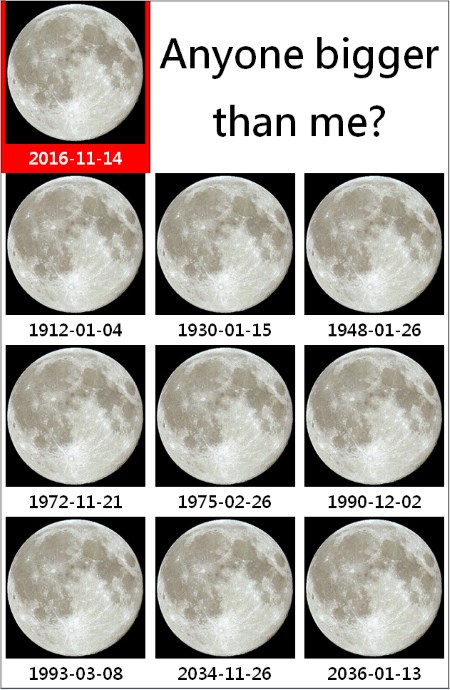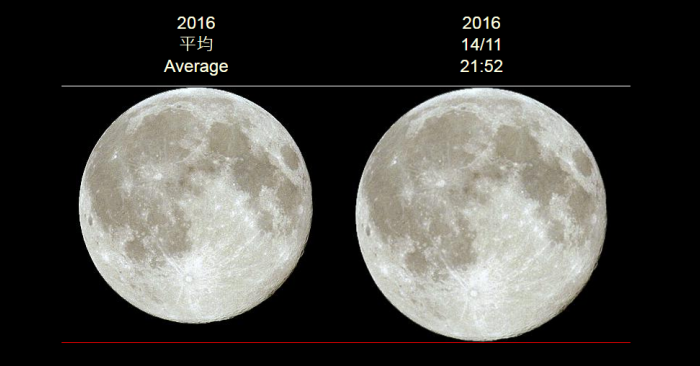How super is 'Super Moon' ?
10 November 2016
While there are 12 to 13 full moons every year, only those on the Mid-autumn Festivals and those coincide with lunar eclipse would attract more public attention. With the growing popularity of astronomical observations and the wide coverage by the media and on social networking platform, the big 'Super Moon'[1] has recently become a hot topic in town.
The biggest 'Super Moon' this year (2016) will occur on the night of 14 November. "How does this 'Super Moon' compare with those in the past?" and "When will a 'Super Moon' be bigger than this one?" are the common questions in mind.
Let's have an eyesight test - Can you identify those 'Super Moons' bigger than the one on 14 November 2016 from the following figure showing the top ten 'Super Moons' between 1901 and 2050?

Here is the answer: The 'Super Moons' in 1912, 1930, 1948 and 2034 are bigger than the one on 14 November 2016, i.e. the 'Super Moon' this year (2016) will be the biggest since 1948 and a bigger one will not occur until 2034.
In fact, using the 'distance between the moon and the earth'[2] as a parameter to compare the size of 'Super Moons', the biggest 100 'Super Moons' between 1901 and 2050 range only between 356,375 km and 357,099 km, whereas using the 'angular diameter'[3] as a parameter, they range only between 0.557o and 0.559o. The difference is so small that it is hardly distinguishable by the naked eyes and even with ordinary instruments.
Then, is there any difference between the 'Super Moon' on 14 November 2016 and an ordinary full moon in the same year?
The table below compares the 'Super Moon' on 14 November 2016 and the 'average value of full moons' in 2016 [4]. One can derive from the 'distance between the moon and the earth' and the 'angular diameter' that the size of the 'Super Moon' will appear around 7 per cent larger than an ordinary full moon.

The figure below shows the visual difference between the 'Super Moon' on 14 November 2016 (right) and an ordinary full moon (left).

With only one moon in sight on 14 November 2016, can you really distinguish the difference between the 'Super Moon' and an ordinary full moon?
Astronomy unit of the Hong Kong Observatory
(H.Y. Mok, David Hui, Otto Cheng, K.C. Fung, W.K. Wong and S.C. Chee)
Notes:
[1] 'Super Moon' is loosely defined as a full moon near the perigee.
[2] 'Angular diameter' is an angular measurement describing how large a sphere or circle appears from a given point of view.
[3] 'Distance between the moon and the earth' is measured from their centre of mass.
[4] 'Average value of full moons' is computed based on all full moons in the year.
Related links:
'Cool Met Stuff' - Mid-Autumn 'Super Moon' (Chinese only): https://www.youtube.com/watch?v=Rgeh-u6wBwA
'Cool Met Stuff' - Moon Illusion (Chinese only): https://www.youtube.com/watch?v=tlqk4J4tFN8
The biggest 'Super Moon' this year (2016) will occur on the night of 14 November. "How does this 'Super Moon' compare with those in the past?" and "When will a 'Super Moon' be bigger than this one?" are the common questions in mind.
Let's have an eyesight test - Can you identify those 'Super Moons' bigger than the one on 14 November 2016 from the following figure showing the top ten 'Super Moons' between 1901 and 2050?

Here is the answer: The 'Super Moons' in 1912, 1930, 1948 and 2034 are bigger than the one on 14 November 2016, i.e. the 'Super Moon' this year (2016) will be the biggest since 1948 and a bigger one will not occur until 2034.
In fact, using the 'distance between the moon and the earth'[2] as a parameter to compare the size of 'Super Moons', the biggest 100 'Super Moons' between 1901 and 2050 range only between 356,375 km and 357,099 km, whereas using the 'angular diameter'[3] as a parameter, they range only between 0.557o and 0.559o. The difference is so small that it is hardly distinguishable by the naked eyes and even with ordinary instruments.
Then, is there any difference between the 'Super Moon' on 14 November 2016 and an ordinary full moon in the same year?
The table below compares the 'Super Moon' on 14 November 2016 and the 'average value of full moons' in 2016 [4]. One can derive from the 'distance between the moon and the earth' and the 'angular diameter' that the size of the 'Super Moon' will appear around 7 per cent larger than an ordinary full moon.

The figure below shows the visual difference between the 'Super Moon' on 14 November 2016 (right) and an ordinary full moon (left).

With only one moon in sight on 14 November 2016, can you really distinguish the difference between the 'Super Moon' and an ordinary full moon?
Astronomy unit of the Hong Kong Observatory
(H.Y. Mok, David Hui, Otto Cheng, K.C. Fung, W.K. Wong and S.C. Chee)
Notes:
[1] 'Super Moon' is loosely defined as a full moon near the perigee.
[2] 'Angular diameter' is an angular measurement describing how large a sphere or circle appears from a given point of view.
[3] 'Distance between the moon and the earth' is measured from their centre of mass.
[4] 'Average value of full moons' is computed based on all full moons in the year.
Related links:
'Cool Met Stuff' - Mid-Autumn 'Super Moon' (Chinese only): https://www.youtube.com/watch?v=Rgeh-u6wBwA
'Cool Met Stuff' - Moon Illusion (Chinese only): https://www.youtube.com/watch?v=tlqk4J4tFN8